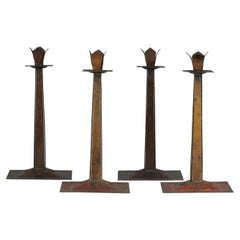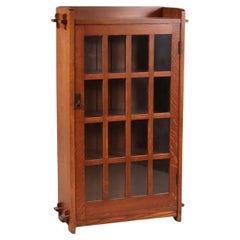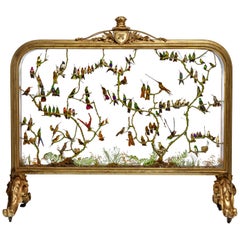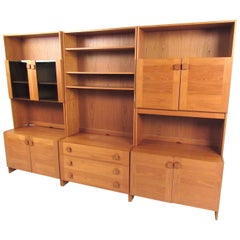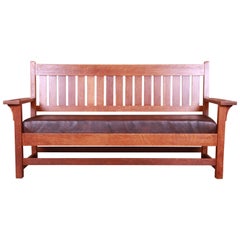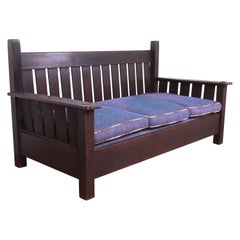Stickley Eastwood
Set of Four Handwrought Copper Candlesticks by Gustav Stickley, circa 1905
Located in New York, NY
Craftsman Workshops of Gustav Stickley, Eastwood, New York
Category
Antique Early 1900s Candlesticks
Materials
Copper
L & JG Stickley Single Door Oak Bookcase
Located in Dallas, TX
L & LG Stickley Oak Bookcase. Circa 1910
A single 16 pane glass window door bookcase with mortise
Category
Vintage 1910s American Bookcases
Materials
Oak
People Also Browsed
Rare Victorian Firescreen with Taxidermy Hummingbirds by Henry Ward
By Henry Ward
Located in Amsterdam, NL
England, third quarter of the 19th century
On two scrolling foliate feet with casters, above which a rectangular two-side glazed frame, with on top a two-sided shield with initial...
Category
Antique Mid-19th Century English High Victorian Taxidermy
Materials
Other
H 51.19 in W 55.12 in D 201.58 in
Scandinavian Modern Teak Wall Unit
Located in Brooklyn, NY
Impressive freestanding teak modular wall unit providing multiple storage and configuration options. The three base and upper cabinets can be arranged as shown or as individual stand...
Category
20th Century Danish Scandinavian Modern Shelves and Wall Cabinets
Materials
Teak
Mission Oak Arts & Crafts Three Panel Screen Room Divider
Located in Port Jervis, NY
Period arts & crafts screen created from quarter sawn oak in a dark finish. In original condition with minimal wear. Simple and elegant work. This item folds flat, each panel is 19.7...
Category
Vintage 1910s American Arts and Crafts Coat Racks and Stands
Materials
Brass
Massive Arts & Crafts Mission Oak Conference Dining Table by J. M. Young
By J. M. Young and Sons, Gustav Stickley
Located in New York, NY
Impressive massive Mission, Arts & Crafts conference table by note American Arts and Crafts maker J.M. Young. The table features two large drawers on each of the two longer ( W ) sid...
Category
Early 20th Century American Arts and Crafts Conference Tables
Materials
Oak
19th Century Gilt Jewelry Cabinet with fitted 17th Century Italian Interior
Located in Troy, NY
Petit, very decorative English gilt cabinet on stand, with an Italian 17th century poker-work interior featuring an intricate system of drawers, including numerous hidden ones. Recon...
Category
Antique 18th Century English Baroque Cabinets
Materials
Wood
H 51 in W 26 in D 16.5 in
Arts & Crafts Oak Barrister Bookcase with Drop Front Secretary Desk, circa 1920s
By Globe Wernicke
Located in South Bend, IN
A gorgeous antique Arts & Crafts barrister bookcase with fall front secretary desk
Recently procured from Frank Lloyd Wright's DeRhodes House
Attributed to Globe Wernicke
US...
Category
Vintage 1920s American Arts and Crafts Bookcases
Materials
Brass
H 47.25 in W 34 in D 14 in
Antique Arts & Crafts Oak Five-Stack Barrister Bookcase by Lundstrom, Circa 1920
By Globe Wernicke
Located in South Bend, IN
A gorgeous antique Mission oak Arts & Crafts five-stack barrister bookcase
By Lundstrom
USA, Circa 1920s
Oak, with glass front doors and brass hardware.
Measures: 33.75" ...
Category
Early 20th Century American Arts and Crafts Bookcases
Materials
Brass
H 78 in W 33.75 in D 11 in
Antique Arts & Crafts Stickley Bros Mission Oak & Leaded Glass Sideboard C1910
By Stickley Brothers
Located in Big Flats, NY
***Ask About Reduced In-House Shipping Rates - Reliable Service & Fully Insured***
An antique Mission Sideboard by Stickley Brothers offers quarter sawn oak construction with mirror...
Category
Early 20th Century American Arts and Crafts Sideboards
Materials
Oak, Glass
H 53 in W 48 in D 19 in
Antique Arts & Crafts Stickley School Mission Oak Bookshelf Circa 1910
By Gustav Stickley
Located in Big Flats, NY
An antique Arts and Crafts bookshelf in the manner of Stickley offers oak construction with four shelves and stylized slat sides, c1910
Measures - 44.5"H x 27.75"W x 14.25"D
Category
Early 20th Century American Arts and Crafts Shelves
Materials
Oak
H 44.5 in W 27.75 in D 14.25 in
Gustav Stickley Mission Oak Arts & Crafts Sideboard, Circa 1900
By Gustav Stickley
Located in South Bend, IN
A rare and exceptional antique Mission oak Arts & Crafts sideboard or credenza with plate rack
By Gustav Stickley
USA, Circa 1900
Quarter sawn oak, with ooze leather lined t...
Category
Early 20th Century American Arts and Crafts Sideboards
Materials
Copper
6FT Arts and Crafts Mission Oak Armoire
Located in Pasadena, TX
6FT Arts and Crafts Mission Oak Armoire
Arts and Crafts oak wardrobe with top cornice, decorative windows and a full-length original beveled mirror door. Opens to a full-length hang...
Category
Early 20th Century North American Arts and Crafts Wardrobes and Armoires
Materials
Oak
Firstaid Cabinet 1970s
Located in Ljubljana, SI
Wall Cabinet 1970s.
Beautiful vintage patina.
Category
Vintage 1970s European Mid-Century Modern Shelves and Wall Cabinets
Materials
Glass, Hardwood
Antique Arts & Crafts Oak Bookcase, Circa 1900
By Stickley Brothers
Located in South Bend, IN
A beautiful antique Arts & Crafts or Late Victorian glass front single door bookcase cabinet
In the manner of Stickley Brothers
USA, Circa 1900
Carved quarter sawn oak, with glass...
Category
Early 20th Century American Arts and Crafts Bookcases
Materials
Brass
Early 1900s Arts and Crafts Oak Wall Coat Rack w. Stunning Majolica Glazed Tiles
Located in Lisse, NL
Beautiful and practical Arts & Crafts coat rack with the best ever majolica glazed tiles.
This stylish Arts and Crafts coat rack is a real joy to own, use and to look at. Over the...
Category
Early 20th Century European Arts and Crafts Coat Racks and Stands
Materials
Metal, Brass
Free Shipping
H 13 in W 26.8 in D 5.5 in
Antique Stickley Brothers Arts & Crafts Desk or Library Table, Newly Restored
By Stickley Brothers
Located in South Bend, IN
An exceptional antique Mission or Arts & Crafts quarter sawn oak writing desk or library table with built-in bookcases
By Stickley Brothers
USA, circa 1900
Measures: 40"W x ...
Category
Early 20th Century American Arts and Crafts Desks and Writing Tables
Materials
Oak
H 30 in W 40 in D 26.5 in
Arts & Crafts Mission Oak with Copper Strapping Cigar Humidor Gustav Stickley
By Gustav Stickley
Located in Port Jervis, NY
Fabulous quarter sawn oak with hand Hammered copper straps and handles with a bronze patina in the style of Gustav Stickley. Has a key with working lock. In excellent antique condit...
Category
Antique Early 1900s American Arts and Crafts Cigar Boxes and Humidors
Materials
Bronze
H 8.75 in W 12.5 in D 15.5 in
Recent Sales
Gustav Stickley Mission Oak Arts & Crafts Settle Sofa, circa 1900
By Gustav Stickley
Located in South Bend, IN
A rare and exceptional Mission Arts & Crafts settle sofa or bench
By Gustav Stickley (original
Category
Antique Early 19th Century American Arts and Crafts Sofas
Materials
Oak
Gustav Stickley Mission Oak Arts & Crafts Settle Sofa, Circa 1900
By Gustav Stickley
Located in South Bend, IN
A rare and exceptional Mission or Arts & Crafts settle sofa
By Gustav Stickley (signed with
Category
Early 20th Century American Arts and Crafts Sofas
Materials
Upholstery, Oak
Gustav Stickley Mission Oak Arts & Crafts Round Dining Table, Newly Restored
By Gustav Stickley
Located in South Bend, IN
Gustav Stickley (original branded label)
Eastwood, NY, circa 1900
Measures: 49.75" W x 49.75" D x
Category
Early 20th Century American Arts and Crafts Dining Room Tables
Materials
Oak
H 30 in W 49.75 in D 49.75 in
Rare Signed Gustav Stickley Mission Oak Arts & Crafts Dining Chairs, Restored
By Gustav Stickley
Located in South Bend, IN
Stickley (signed with original branded label)
Eastwood, NY, circa 1900
Solid quarter sawn oak frames
Category
Antique Early 1900s American Arts and Crafts Dining Room Chairs
Materials
Brass
H 36.38 in W 16.88 in D 18.5 in
Gustav Stickley 3 Drawer Library Table No. 619
Located in Fulton, CA
Fine Arts & crafts library table by Gustav Stickley. Signed with Eastwood paper label.
Category
Early 20th Century American Desks and Writing Tables
Materials
Oak
Get Updated with New Arrivals
Save "Stickley Eastwood", and we’ll notify you when there are new listings in this category.
More Ways To Browse
Stickley Oak Mission Style Chair
Stickley Couch
Stickley Sofa
Used Stickley Sofa
Antique Mission Settle
G Plan Bookcase
Mission Morris Chair
Stickley Mission Couch
Bronze Lg
Stickley Dining Set
Stickley Oak Bench
Stickley Oak Sofa
Eastwood Chair
Stickley Grand Rapids
Stickley Oak Dining Chairs
Antique Mission Oak Dining Room Set
Stickley Brothers Grand Rapids
Stickley Dining Room Set
